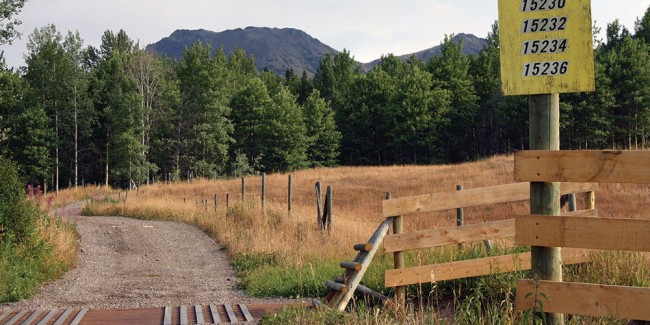
Photo Credit: Norma Kerby
Grand Entrances: Northerners and the long drive home
“Map says it’s public right-of-way.”
Ken and I are conducting a survey of agricultural use in the Greater Terrace Area, which involves driving down every publicly accessible road, sub-road and trail looking for greenhouses, fruit trees and farm animals to get an indication of commercial and non-commercial farming in the area.
This particular driveway stretches down a public right-of-way, then disappears around the corner into thick hemlock trees.
“They certainly put up enough signs,” I mutter.
From the “Do Not Trespass,” “No Entry” and “Beware of Dog” signs to the heavy-gauge chain across the road, there’s no mistaking either the message or the annexation of public property. As four large dogs come barrelling toward us, we quickly decide this lot will be marked “unknown.”
For the rest of the day, as we continue the survey, long driveways are the point of discussion. Many properties we view have the sort of access road that, if there were a long, snowy winter, would be very difficult to keep open.
Access granted
Access is a major challenge in northern BC’s rural living. Unlike urban driveways, which meet streets in a matter of meters, many rural dwellers have driveways that are 100 metres, if not hundreds of meters, long. Long driveways seem to be the mark of the rural northern lifestyle and reasons for having them can be enlightening.
Some are the product of historic land development and the continued importance of agriculture in the North. In many farming regions, such as the Fort St. James and Vanderhoof areas, rural land is divided into sections and portions of sections, 640 acres being a full section.
Secondary roads follow property lines and the farmhouse is often strategically located where water can be reached by either well or surface pump. View over the farm property is also an important consideration, as is location on a warm, south-facing slope or in a sheltered site away from ferocious winter winds.
With readily available equipment to maintain and plow the driveway, its length is not a major factor compared to a good location for farm buildings. These are friendly driveways, with a smile and piece of pie waiting at the end.
Ranchers often have a different set of criteria for driveways. Ranches might be located on less arable, more challenging ground and access into properties may be at a significant distance from a major road. Branching off from industrial logging or mining roads, their driveways assume that visitors have a four-wheel-drive truck. I don’t, making some journeys an exercise in steel nerves, especially when it rains heavily. One must always be convinced that there is a road somewhere underneath the thick, silty surface soup as the vehicle slides toward the ranch house.
When questioned why they didn’t build closer to the road, the common explanation from people with livestock is that, one, they built their ranch buildings in a location that was best for water and winter stock pens and, two, vandalism, theft and rustling are less likely when access is more challenging. The third reason is straightforward: with so little traffic able to make it to their driveway, let alone down the driveway, there’s lots of warning about an approaching visitor.
Farmers and ranchers have working driveways, designed for moving equipment and livestock. These driveways have few frills, except perhaps a sign stating the property number, a message box and sometimes a gate. Their driveways are access to the home place, with no further need for explanation.
In comparison, driveways into rural residential properties often provide bold statements about their owners. Whether it is a pink plastic flamingo, an old wagon wheel or a pile of rocks, rural residents have imaginative ways of identifying their driveways. With the advent of 911 service into rural areas, most driveways now have house numbers at the front end, but the special tokens remain. Directions to someone’s place can run something like, “Turn right at the community mail boxes and we are the third driveway to the left with the old tractor next to the cattle guard.”
Keyholes to gargoyles
Long driveways into rural residential lots can arise from the need to avoid dust or noise spilling over from a main road, placing distance between a busy road and children or animals in the yard, or just plain control over privacy. It is always assumed that the next-door neighbour will have a shortcut through the back if they need to borrow something.
For some, privacy is taken to a much higher level. As we travel throughout northwest BC, we are surprised at the lengths to which some residents conceal their homes. Sometimes there are no indications of the driveway except for a branchy hole in the bushes that disappears into the forest. This type of driveway is betrayed only by a weekly garbage can placed at the roadside or a bit of flagging tape left to direct a visitor. One can only imagine what lies beyond.
Other driveways are grand entrances to privacy. Stone pillars topped by plaster lions and thick steel gates are only a hint of the luxury and display waiting at the end. These are a strange contradiction between the need for privacy and the urge for conspicuous display.
Some of my favourite driveways are on Haida Gwaii. Decorated with unusual driftwood and large plastic floats, they are a splash of colour amongst the greens and mist, winding between trees to hand-built houses. When we first travelled to the islands, we wondered why so many driveways stretched to houses located away from the seashore on higher ground. Having heard stories about back-to-the-landers who once lived next to the waves before Naikoon Provincial Park was established, this was a puzzle. It wasn’t until talking to one farmer selling fresh eggs that we realized the wisdom of his long driveway away from the shoreline’s storm winds and tsunami hazards.
Long driveways are like a security blanket to maintain a time and place, factors that seem to be disappearing from the lives of many. At the end of the driveway, rural northerners plant their gardens, split wood for winter, let chickens run loose before the fox shows up, and leave their snowmobiles in unlocked sheds.
It must be a deep, soul-shattering shock for some rural residents to realize that their long driveways cannot insulate them against the surge of linear industrial development scheduled to pass over or next to their properties. For the residents of such special environments as the Kispiox and Nass valleys, the attention of the world on the economic opportunities of the North Coast is invalidating the security once offered by their long driveways.





